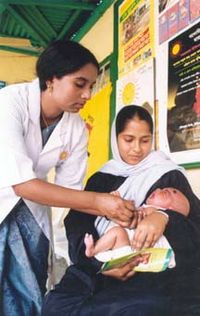
Photo from wikipedia
Introduction There is inadequate information on the cost-effectiveness of hypertension based on evidence-based guidelines. Therefore, this study was conducted to evaluate the cost-effectiveness of hypertension treatment based on 2020 International… Click to show full abstract
Introduction There is inadequate information on the cost-effectiveness of hypertension based on evidence-based guidelines. Therefore, this study was conducted to evaluate the cost-effectiveness of hypertension treatment based on 2020 International Society of Hypertension (ISH) guidelines from a societal perspective. Methods We developed a state-transition Markov model based on the cardiovascular disease policy model adapted to the Sub-Saharan African perspective to simulate costs of treated and untreated hypertension and disability-adjusted life-years (DALYs) averted by treating previously untreated adults above 30 years from a societal perspective for a lifetime. Results The full implementation of the ISH 2020 hypertension guidelines can prevent approximately 22,348.66 total productive life-year losses annually. The incremental net monetary benefit of treating hypertension based was $128,520,077.61 US by considering a willingness-to-pay threshold of $50,000 US per DALY averted. The incremental cost-effectiveness ratio (ICER) of treating hypertension when compared with null was $1,125.44 US per DALY averted. Treating hypertension among adults aged 40–64 years was very cost-effective 625.27 USD per DALY averted. Treating hypertensive adults aged 40–64 years with diabetes and CKD is very cost-effective in both women and men (i.e., 559.48 USD and 905.40 USD/DALY averted respectively). Conclusion The implementation of the ISH 2020 guidelines among hypertensive adults in Southern Ethiopia could result in $9,574,118.47 US economic savings. Controlling hypertension in all patients with or with diabetes and or CKD could be effective and cost-saving. Therefore, improving treatment coverage, blood pressure control rate, and adherence to treatment by involving all relevant stakeholders is critical to saving scarce health resources.
Journal Title: PLoS ONE
Year Published: 2022
Link to full text (if available)
Share on Social Media: Sign Up to like & get
recommendations!